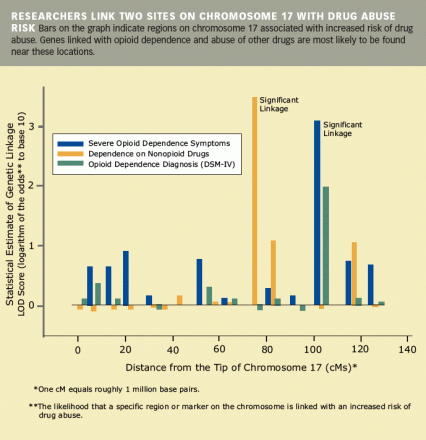NIDA-funded investigators are homing in on the location of genes that may influence the risk of opioid dependence. Dr. Joel Gelernter, at Yale University School of Medicine, Henry Kranzler, at the University of Connecticut, and colleagues led a study that has shown a statistical link between one region on chromosome 17 and an increased risk of opioid dependence.
 Researchers Link Two Sites on Chromosome 17 With Drug Abuse Risk: Bars on the graph indicates regions on chromosome 17 associated with increased risk of drug abuse. Genes linked with opioid dependence and abuse of other drugs are most likely to be found near these locations.
Researchers Link Two Sites on Chromosome 17 With Drug Abuse Risk: Bars on the graph indicates regions on chromosome 17 associated with increased risk of drug abuse. Genes linked with opioid dependence and abuse of other drugs are most likely to be found near these locations."Opioid addiction results from the activities of multiple genes, many environmental factors—obviously including drug exposure—and interactions among them. Our findings point to specific chromosomal areas as the sites of some of the contributing genes," says Dr. Gelernter. Prior studies that estimated the relative contributions of genes and environmental factors by comparing rates of addiction in twins indicated that genes alone account for an estimated 45 percent to 50 percent of opioid addiction. Twin studies also suggest that certain genes may increase the risk of opioid addiction without affecting the likelihood of addiction to other drugs.
Scanning for Genetic Markers
At four sites in the eastern United States, Dr. Gelernter and colleagues recruited 393 families with at least one member who abused opioids; in 235 of the families (60 percent), two or more members abused the drugs. The investigators assessed every study participant and categorized those who reported abusing drugs as exhibiting either "low opioid abuse," "moderate opioid abuse," "severe opioid abuse," "abuse of nonopioid drugs," or "severe opioid abuse mixed with dependence on other substances." Participants in the "severe opioid abuse" cluster reported the highest rates of long-term heavy abuse, injection of opioids, and attempts to quit.
The researchers scanned each participant's DNA for genetic markers—segments of DNA that occur at known locations on a particular chromosome. These scans revealed that certain markers were shared with increased frequency among family members with drug abuse diagnoses or phenotypes; the specific genes that influence risk for opioid dependence are likely to be found near these markers.
Among the markers with the strongest statistical links Dr. Gelernter's team identified were two on the long arm of chromosome 17 (see chart). One of these was connected with severe symptoms of dependence on opioids, but not other drugs, among both African-American and European-American participants. Among European-American participants only, a second site was linked with dependence on other drugs, including cocaine, nicotine, alcohol, and marijuana.
Although the sites on chromosome 17 were the only ones to show statistically significant linkages, the analyses suggested that the short arm of chromosome 11 and the long arm of chromosome 3 may also feature genes that influence dependence on nonopioid drugs. Among African-American participants only, analyses suggested a link between opioid dependence and a site on chromosome 2. The genetic sites linked with risk of many health problems differ between European- and African-Americans. Known racial differences in the patterns of drug abuse and risk factors for addiction also support somewhat separate etiologies, although there is likely much overlap.
The findings generally accord with those of prior studies. For example, other researchers have linked sites on chromosome 17 with the risk of smoking and conduct disorder. Further, chromosome 17 has a site, albeit in a different location than the ones found by Dr. Gelernter's team, with a suggestive linkage to heroin abuse among almost 200 families from Yunnan Province in China, according to preliminary findings from NIDA-funded investigators Drs. Ming T. Tsuang and Stephen J. Glatt and colleagues. Similarly, prior studies have linked sites close to the ones observed by Dr. Gelernter's team on chromosome 11 with risk of nicotine and alcohol addiction and areas of chromosome 3 with risk of cocaine abuse and conduct disorder.
Identifying Specific Genes
Studies such as Dr. Gelernter's suggest that certain areas of the genome are statistically most likely to harbor genes that play a role in drug abuse. Researchers will next turn their attention to the question: Which of the genes that reside in these areas might explain that increased likelihood? Prime candidates will be any genes whose activities affect physiological responses to drugs or behavioral characteristics associated with vulnerability to drug abuse. "Each chromosome site where we observed a link could have perhaps 30 to 100 genes, maybe more, and my team is currently assigning each region a priority for further study," says Dr. Gelernter. Scientists may investigate candidate genes' impacts in a variety of ways, including statistical studies to determine the effects of eliminating, activating, or inactivating the genes on animals' responses to drugs.
"The findings of both genomewide and candidate-gene studies represent a good return on NIDA's investment in genetics research and contribute useful and complementary information," says Dr. Harold Gordon of the Division of Clinical Neuroscience and Behavioral Research. "Besides identifying genes that put people at risk for the disorder, they help us understand how these genes affect neural function and behavior, and facilitate the development of medications tailored to the individual."
By scanning for genetic markers common among a subgroup of individuals with the most severe opioid abuse symptoms, Dr. Gelernter's team was able to home in on sites that may harbor genes linked with the unique risk for opioid dependence, as well as those linked to substance abuse in general, Dr. Gordon notes. In future studies, the team hopes to use a newer genomewide scanning technique that can dramatically speed the identification of specific genes.
Source
Gelernter, J., et al. Genomewide linkage scan for opioid dependence and related traits. American Journal of Human Genetics 78(5):759-769, 2006. [Abstract]